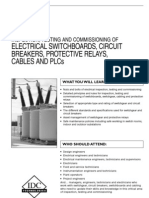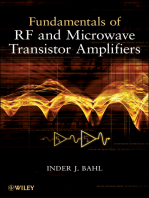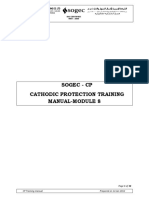Basics of Industrial Electricity and Troubleshooting Electrical Control Circuits
Basics of Industrial Electricity and Troubleshooting Electrical Control Circuits
Uploaded by
jjithendranathCopyright:
Available Formats
Basics of Industrial Electricity and Troubleshooting Electrical Control Circuits
Basics of Industrial Electricity and Troubleshooting Electrical Control Circuits
Uploaded by
jjithendranathOriginal Title
Copyright
Available Formats
Share this document
Did you find this document useful?
Is this content inappropriate?
Copyright:
Available Formats
Basics of Industrial Electricity and Troubleshooting Electrical Control Circuits
Basics of Industrial Electricity and Troubleshooting Electrical Control Circuits
Uploaded by
jjithendranathCopyright:
Available Formats
BASICS OF INDUSTRIAL ELECTRICITY AND
TROUBLESHOOTING ELECTRICAL CONTROL CIRCUITS
Learn how to effectively diagnose electrical control CLASS FORMAT:
circuit problems. You will experience live circuit Lab + classroom
faults in a real world scenario. Become a confident
and safe troubleshooter from techniques presented. The participant is able to “learn-by-doing” in the course;
this knowledge can be transferred to the workplace.
Understand the basics of electricity generation and
delivery. Learn to safely use the proper measurement STANDARD CLASS SIZE:
instruments and tools to understand the characteristics
NTT recommends a course size of 12 participants for
and properties of electrical signals. The terms voltage,
the best results.
current and impedance (resistance) will become
standard in your electrical conversations.
NTT PROVIDES:
Work hands-on with the same control circuits and devices
• 5-Days (40 contact hours) of on-site instruction
commonly used on HVAC systems, pump systems,
• Textbooks, “Troubleshooting Electrical Control
hydraulics, conveyors and automated machines.
Circuits,” and “Basics of Industrial Electricity,”
This program is ideal for apprentice electricians just “Safety Awareness” and lab manuals
starting out, journeymen wishing to upgrade their • Classroom consumables
skills, or any engineering, maintenance, operations, • Completion certificates
or management personnel who come into contact
• Shipping and instructor travel logistics
with electrical control systems in the course of their
daily activity. They will benefit by being able to find, CLIENT PROVIDES:
understand and fix electrical problems more easily,
• The classroom, with easy access, of 750 square feet
thereby reducing downtime.
or greater
• Projection screen, white board and/or flip chart(s)
• A dock facility or forklift
• A pallet jack to move the crates around after they
have been unloaded may also be needed
• The equipment needs to be relocated to the
training room for the NTT instructor to test and set
up prior to the course start
SHIPPING:
Six Cases at 2050 lbs
• 1 @ 58” x 47” x 62”
• 5 @ 47” x 22” x 17”
Training 800.922.2820 | www.NTTInc.com
BASICS OF INDUSTRIAL ELECTRICITY AND
TROUBLESHOOTING ELECTRICAL CONTROL CIRCUITS
COURSE AGENDA
BASIC ELECTRICITY SOLID-STATE DEVICES
• Current, voltage, and resistance • Resistor color codes
• Ohm’s Law and calculations • Resistor board*
• Series-parallel circuits • Diodes and continuity*
• Kirchhoff’s Laws and corollaries • Rectifiers
• Capacitor sine waves
BASICS OF MULTIMETERS • Capacitor check*
• Analog and digital multimeters • Solid-State switches
• Solenoid meters • Checking a solid-state switch*
• Accessories
PROTECTIVE DEVICES
ELECTRICAL SAFETY • Fuses and disconnect switches
• Basic safety guidelines • Circuit breakers, panels, and switchgear
• Lockout/tagout • Overload devices
• Test safety equipment • Checking protective devices
• Electrical shock • Ground-fault protection
• Arc flash • Grounding and isolating
• Arc blast • Phase reversal
• Surge protection
ELECTRICIANS’ TOOLS AND TEST EQUIPMENT
• Coordination and selectivity
• Tools for conduit
• Phase-rotation meter LIGHTING SYSTEMS
• The megohmmeter • Incandescent and fluorescent
• Voltage and continuity testers • HID lamps
• Lighting circuits
GENERATORS AND TRANSFORMERS
• Series, parallel, and series-parallel lamps
• DC power sources and voltmeter
• Measuring DC volts* COMMON WIRING DEVICES
• AC generators • Receptacles
• Generators sinewave voltage • Specification grade, isolation, and hospital grade
• 3-phase AC • NEMA locking
• Current lag/lead waveform • Wiring a receptacle, troubleshooting receptacles & GFCI
• Transformers including Control Transformers • Lighting outlets—switches and dimmers
• Transformer voltages* • Switch operation and installation
• Wyes and deltas • 3- and 4-way switches
• Measuring a wye • Testing and installing 3- and 4-way switches
*Lab Exercises
Training 800.922.2820 | www.NTTInc.com
BASICS OF INDUSTRIAL ELECTRICITY AND
TROUBLESHOOTING ELECTRICAL CONTROL CIRCUITS
COURSE AGENDA
CONDUCTORS AND RACEWAYS BASICS OF INDUSTRIAL ELECTRICITY HANDS-ON
• Insulation and ampacity LAB EXERCISES
• Solid and stranded cable • Basic trainer set up
• Conduit-metal and nonmetallic • Series circuit
• Splices: wirenuts, crimps, terminal blocks, split bolts and • Parallel circuit
solder • Series-parallel circuits
• Conductor and box fill • DC voltage
• Parallel conductors • Transformers
• 2-, 3-, and 4-wire circuits • Resistors
• Capacitor
ELECTRICAL DRAWING AND SYMBOLS • Rectifiers
• Drawing symbols • Problem receptacles
• Blueprints • Single-pole switch multiple-way switches
• One-line drawings
• NEMA symbols ELECTRICAL SCHEMATICS
• Schematics • Power circuits
• Ladder diagrams • Control circuits
• Physical layout
MAPPING CONTROL CIRCUITS—
RELAYS LADDER DIAGRAMS
• Motor Starters • Power rails and wire colors
-- Basic Parts to a motor starter and their function • Control element arrangement
-- MCP – motor circuit protection • Load arrangement
»» Replacing overloads • Circuit protection arrangement
»» Adjustable trip breaker settings • Line numbers
• Wire numbers
MOTORS • Tag names and common electrical symbol abbreviations
• Single-phase, three-phase and DC
• Connection diagrams CONTROL ELEMENTS, SWITCHES
• Motor construction AND SYMBOLOGY
• Theory of operation • Relay contacts—normally open, normally closed
• Basic Parts of a motor • Solid-state relays
-- Motor types • Timing relays
-- De-terminating the motor via motor terminal box • Overload relays
-- Motor replacement - Dismounting and mounting
-- Reconnecting the motor SUPPLEMENTARY CONTACT SYMBOLS
-- Checking and correcting AND TERMS
• Phase/Rotation • Breaks, poles, throws
• Single break, double break
• Single pole, double pole
• Single throw, double throw
Training 800.922.2820 | www.NTTInc.com
BASICS OF INDUSTRIAL ELECTRICITY AND
TROUBLESHOOTING ELECTRICAL CONTROL CIRCUITS
COURSE AGENDA
MANUAL SWITCHES—FUNCTIONALITY HANDS-ON LAB EXERCISE CIRCUITS
AND SYMBOLOGY • Two-wire control and hands-off/auto
• Selector switches • Three-wire control—start/stop
• Push buttons • Jog/inch circuits
• Drum and foot switches • Sequencing start and stop circuits
• Timing circuits
AUTOMATIC SWITCHES • Automatic sequencing circuits
• Limit switches • Forward/reversing circuits
• Temperature, pressure, flow, and float switches • Plug stop and anti-plugging circuits
• Motion switches • Two-speed motor control
• Proximity and photo switches • Reduced voltage starting circuits
TROUBLESHOOTING SUGGESTIONS
• Measuring ohms, voltage, and current
• Open faults vs. shorts
• Using the proper tools and meters
• Logical and sequential troubleshooting methods
• Meter categories and types
• Safety and precautions
GROUND-FAULT & OVERLOAD PROTECTION
• Conductor sizing
• Ground-fault protection devices and sizing
• Motor starter sizing
• Motor overload protection sizing
• Disconnect sizing
MOTOR OVERLOAD PROTECTION
• Thermal overloads
• Bimetallic overloads
• Magnetic overloads
• Solid-state overloads
Training 800.922.2820 | www.NTTInc.com
You might also like
- Nissan Electrical Components Diagnosis and RepairDocument339 pagesNissan Electrical Components Diagnosis and RepairARUSCHEL81% (21)
- Fundamentals of Electrical Maintenance PDFDocument4 pagesFundamentals of Electrical Maintenance PDFelmerNo ratings yet
- Boatowner's Mechanical and Electrical Manual: How to Maintain, Repair, and Improve Your Boat's Essential SystemsFrom EverandBoatowner's Mechanical and Electrical Manual: How to Maintain, Repair, and Improve Your Boat's Essential SystemsRating: 4.5 out of 5 stars4.5/5 (11)
- Practical Electrical Wiring: Residential, Farm, Commercial, and IndustrialFrom EverandPractical Electrical Wiring: Residential, Farm, Commercial, and IndustrialRating: 3.5 out of 5 stars3.5/5 (3)
- Introduction To Industrial Electronics: Course AgendaDocument2 pagesIntroduction To Industrial Electronics: Course AgendaAwais khalidNo ratings yet
- Circuit Breakers and Switch GearDocument2 pagesCircuit Breakers and Switch GearMilind DombaleNo ratings yet
- Commissioning Services FoldedDocument4 pagesCommissioning Services Foldedkarimi-15No ratings yet
- Pneumatic/Electro-Pneumatic Systems and Principles: Course OutcomesDocument2 pagesPneumatic/Electro-Pneumatic Systems and Principles: Course OutcomesIwan KurniawanNo ratings yet
- Wiring StandardsDocument2 pagesWiring StandardsNguyen HungNo ratings yet
- Power TransformersDocument2 pagesPower TransformersAravinth Ramanathan0% (1)
- toolstechniquesforcommissioningandmaintainingpvsystemsw-animationsfinal-240618195906-ad1e980b (1)Document39 pagestoolstechniquesforcommissioningandmaintainingpvsystemsw-animationsfinal-240618195906-ad1e980b (1)James K. BitokNo ratings yet
- Fluke Clamp Meters: Solutions For Every NeedDocument6 pagesFluke Clamp Meters: Solutions For Every NeedAl Nino AalNo ratings yet
- Prof VKJain-Switchyard OverviewDocument23 pagesProf VKJain-Switchyard OverviewGAURAV KUMAR PATHAKNo ratings yet
- 180221114750CEP - Competent Electrical PersonDocument5 pages180221114750CEP - Competent Electrical PersonRajesh KumarNo ratings yet
- ArcFlashAdvisors PDFBrochureDocument2 pagesArcFlashAdvisors PDFBrochureMahan HabibiNo ratings yet
- House WiringDocument6 pagesHouse WiringLokender SinghNo ratings yet
- Labvolt Series 3351: Ac/Dc Training SystemDocument2 pagesLabvolt Series 3351: Ac/Dc Training SystemEric MendozaNo ratings yet
- Testing of High Voltage Equipment PDFDocument2 pagesTesting of High Voltage Equipment PDFsarabNo ratings yet
- DT400 & 436 Data SheetDocument4 pagesDT400 & 436 Data SheetGanapathy SadayanNo ratings yet
- ECE - 6618PD - Course Outline W 2021Document2 pagesECE - 6618PD - Course Outline W 2021Matthew MicallefNo ratings yet
- AURETR129 Diagnose and Repair Charging Systems V1Document237 pagesAURETR129 Diagnose and Repair Charging Systems V1jaredmuge808No ratings yet
- 9574 - Switchgear and Protection LabDocument2 pages9574 - Switchgear and Protection LabadtronNo ratings yet
- Troubleshooting of Electronic CircuitsDocument2 pagesTroubleshooting of Electronic Circuitsmoh_68100% (1)
- Electrical Switchboards, Circuit Breakers, Protective Relays, Cables and PlcsDocument2 pagesElectrical Switchboards, Circuit Breakers, Protective Relays, Cables and PlcsIndika JayasundaraNo ratings yet
- Electrical Installation AND Maintenance NC Ii: Reporters: Meril S. Mercado Elizabeth P. OlarveDocument30 pagesElectrical Installation AND Maintenance NC Ii: Reporters: Meril S. Mercado Elizabeth P. Olarveelizabeth olarveNo ratings yet
- Westinghouse ProfileDocument16 pagesWestinghouse ProfileBalaji ElanchezhiyanNo ratings yet
- 7420121428595415775Document6 pages7420121428595415775Gopinath SubramaniNo ratings yet
- Protection Coordination ETAPDocument108 pagesProtection Coordination ETAPHồ Tấn Tài100% (4)
- Power Electronics Laboratory User Manual: Revised: March 18, 2009Document51 pagesPower Electronics Laboratory User Manual: Revised: March 18, 2009srinivasulupadarthi100% (1)
- 03 Slights Electrical Wiring PDFDocument39 pages03 Slights Electrical Wiring PDFDINESHNo ratings yet
- 3rd Solar PV Bootcamp Syllabus and Reg FormDocument5 pages3rd Solar PV Bootcamp Syllabus and Reg FormJb SantosNo ratings yet
- Electrical Installation 1Document2 pagesElectrical Installation 1mauriceokinyiochiengNo ratings yet
- SMPS Laboratory InstructionsDocument28 pagesSMPS Laboratory InstructionsM.Seddik DOUARNo ratings yet
- Session10MichaelCoddingtonNREL ReviewDocument30 pagesSession10MichaelCoddingtonNREL ReviewKrisDom - InvestorNo ratings yet
- Testing of High Voltage EquipmentDocument2 pagesTesting of High Voltage EquipmentRabin Babu GhimireNo ratings yet
- Act2 VNDocument77 pagesAct2 VNPhan Sư ÝnhNo ratings yet
- Earthing, Bonding, Lightning Surge ProtectionDocument2 pagesEarthing, Bonding, Lightning Surge ProtectionKonda SrinivasNo ratings yet
- Electrician Course ContentsDocument1 pageElectrician Course ContentsTariq Rahim MarwatNo ratings yet
- Protection & Coordination R1 2015Document111 pagesProtection & Coordination R1 2015Marioyfernanda Guerra Murua100% (3)
- Module 2Document48 pagesModule 2sungadomsNo ratings yet
- Rig Electrician CourseDocument4 pagesRig Electrician CourseGrid Lock100% (2)
- Testing of Solar InvertersDocument38 pagesTesting of Solar InvertersVignesh KumarNo ratings yet
- Lecture Fuse Breakers and Panel BoardsDocument38 pagesLecture Fuse Breakers and Panel Boardsthomas goNo ratings yet
- High and Medium Voltage Substation Design, Testing & MaintenanceDocument4 pagesHigh and Medium Voltage Substation Design, Testing & MaintenanceShahraiz KhanNo ratings yet
- 1431928880session II CBDocument84 pages1431928880session II CBAnonymous i2u3XW8UJHNo ratings yet
- Solar Technician Test Preparation Guide, 3-2023Document11 pagesSolar Technician Test Preparation Guide, 3-2023EstebanBadillaAlvaradoNo ratings yet
- Electrical Course ContentDocument6 pagesElectrical Course ContentMohd SalahuddinNo ratings yet
- Good DAY Toall!Document12 pagesGood DAY Toall!cynthiaNo ratings yet
- Electrical Instrumentation Occupational ProfileDocument2 pagesElectrical Instrumentation Occupational ProfileYirgalem AddisNo ratings yet
- Upstream Line Card: Solutions For Oil and GasDocument4 pagesUpstream Line Card: Solutions For Oil and Gasjeyakumar007No ratings yet
- Ac Circuit Syllabus 2Document12 pagesAc Circuit Syllabus 2ferdinandNo ratings yet
- Electrical Engineering For Non Electrical Engineers (June 2023)Document10 pagesElectrical Engineering For Non Electrical Engineers (June 2023)Azizulzaman JamaludinNo ratings yet
- 12-2 Onsite Cable Testing Rev1Document50 pages12-2 Onsite Cable Testing Rev1Emir Kamberovic100% (2)
- LI IndustryDocument13 pagesLI IndustryhariNo ratings yet
- Protection 2-RelaysDocument13 pagesProtection 2-RelaysdasundealwisNo ratings yet
- Boat Maintenance Companions: Electrics & Diesel Companions at SeaFrom EverandBoat Maintenance Companions: Electrics & Diesel Companions at SeaNo ratings yet
- Analog Dialogue Volume 46, Number 1: Analog Dialogue, #5From EverandAnalog Dialogue Volume 46, Number 1: Analog Dialogue, #5Rating: 5 out of 5 stars5/5 (1)
- Testing Coolant Temperature Sender - G62Document2 pagesTesting Coolant Temperature Sender - G62Dan AvNo ratings yet
- Experiment#01: To Study The Electrical Symbols, Power Sources, Electrical Measuring Instruments and Bread BoardDocument4 pagesExperiment#01: To Study The Electrical Symbols, Power Sources, Electrical Measuring Instruments and Bread BoardNasirAbbasNo ratings yet
- Core Loss TestDocument3 pagesCore Loss TestgaladrialNo ratings yet
- Testing Electronic Components PDFDocument105 pagesTesting Electronic Components PDFZoran Trajkovic100% (1)
- XG AC DC Annual Maint ScheduleDocument28 pagesXG AC DC Annual Maint ScheduleAnonymous YPx8ss48No ratings yet
- Ec 303Document2 pagesEc 303jeetendrasidhiNo ratings yet
- The Multi - Tester: Technology and Livelihood Education-Grade 9 Quarter 2, Week 3Document8 pagesThe Multi - Tester: Technology and Livelihood Education-Grade 9 Quarter 2, Week 3Sori Dens0% (1)
- Electric Potential and Electric Field Mapping - VillanuevaDocument22 pagesElectric Potential and Electric Field Mapping - VillanuevaCristy Mae U. VillanuevaNo ratings yet
- HOW TO MAKE A PORTABLE WIND TURBINE - 8 Steps (With Pictures) - InstructablesDocument22 pagesHOW TO MAKE A PORTABLE WIND TURBINE - 8 Steps (With Pictures) - InstructablesMeim HakkasNo ratings yet
- HardwareDocument121 pagesHardwareSomnath KhamaruNo ratings yet
- Tools, Equipment and Testing DevicesDocument8 pagesTools, Equipment and Testing DevicesJohnny Pancito RodriguezNo ratings yet
- Fluke 8808a Multimeter ManualDocument100 pagesFluke 8808a Multimeter ManualCaio PaulinoNo ratings yet
- 202 Lab 5. RC CircuitsDocument8 pages202 Lab 5. RC CircuitsNahid SultanNo ratings yet
- 2004 Ford Pickup 5.4l Eng f150 p0340Document28 pages2004 Ford Pickup 5.4l Eng f150 p0340Thomas AndersonNo ratings yet
- GENII - Toyota Landcruiser - 105 Series 4 Speed Petrol & Diesel - Lock Up Instructions New LoomDocument14 pagesGENII - Toyota Landcruiser - 105 Series 4 Speed Petrol & Diesel - Lock Up Instructions New LoomTony NgatiaNo ratings yet
- Manual Multimetro MetermanDocument2 pagesManual Multimetro MetermanMarco CortésNo ratings yet
- Service ListDocument10 pagesService Listviethuong96No ratings yet
- Experiment 3:-: Measurement of Average and Rms Value of Different Signal WaveformsDocument6 pagesExperiment 3:-: Measurement of Average and Rms Value of Different Signal WaveformsWA Q ASNo ratings yet
- R SERIES DEFIBDocument170 pagesR SERIES DEFIBSamad SiddiquiNo ratings yet
- Chapter One Construction and Design of ADocument50 pagesChapter One Construction and Design of Aoguche emmanuelNo ratings yet
- Fuel Systems: Multi-Port and Throttle Body Fuel InjectionDocument194 pagesFuel Systems: Multi-Port and Throttle Body Fuel InjectionCicero PaulaNo ratings yet
- Access CatalogDocument24 pagesAccess CatalogAccess TechnologiesNo ratings yet
- Multímetro Digital RadioShack 42-RangeDocument7 pagesMultímetro Digital RadioShack 42-RangeLuis SaavedraNo ratings yet
- Electronics Devices LabDocument110 pagesElectronics Devices LabMemoursNo ratings yet
- Sony kv-34fs100 Chassis Ba5dDocument215 pagesSony kv-34fs100 Chassis Ba5dDaniel NeloNo ratings yet
- Datasheet - Live: Agilent 34410A/11A 6 Digit MultimeterDocument152 pagesDatasheet - Live: Agilent 34410A/11A 6 Digit Multimeteressen999No ratings yet
- CP Training Maual-Module 8-Field Measurement and Testing of CP Sys...Document38 pagesCP Training Maual-Module 8-Field Measurement and Testing of CP Sys...Emre Erdem100% (1)
- klv22bx300 PDFDocument112 pagesklv22bx300 PDFPravin JadavNo ratings yet
- dw23271602 PDFDocument443 pagesdw23271602 PDFP GlNo ratings yet

























































































